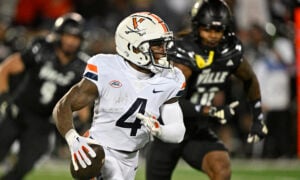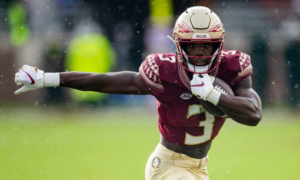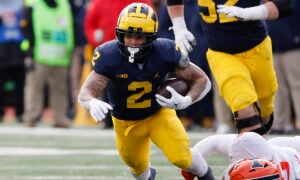FFPC $1,250 Start-up Draft Review
Editor’s Note: Welcome to our coverage of the FFPC’s high-stakes dynasty format. The FFPC games are unlike any other in the industry due to their reputation and visibility in the space. From their first introduction in 2010, they only continue to gain in popularity.
Welcome to the first installment of our 2016 FFPC draft coverage and our FIRST start-up draft for their dynasty format of 2016!
DLF and the FFPC are partners once again in 2016 and we’re covering drafts to be used as another source of reference for your own drafts. The thought here is that the “high stakes” element brings with it a high degree of fantasy coaching experience and performance. These coaches are putting serious money on the line with the hope of greater payouts at the end of the rainbow and you can bet that most put a lot of work and research into each selection. With this particular FFPC dynasty league requiring a $1,250 entry fee, there’s no room for mistakes.
This review is for a $1,250 12-team start-up draft. Standard scoring Point Per Reception (PPR) format with the exception that tight ends receive 1.5 PPR. Passing touchdowns are worth the standard four points while rushing and receiving touchdowns bring six points each. Starting rosters are as follows: 1 QB, 2 RB, 2 WR, 1 TE, 2 Flex, 1 K, 1 DEF/ST. One note about the FFPC Dynasty format: Each team has 20 total roster spots with one each given to kickers and Defense. At the end of each year, teams must drop four players to reach a total of 16 total players. This makes for a relatively shallow roster with emphasis on productive players.
You can see all of the rules at MYFFPC.com.
If you’re ready to step up to the most serious dynasty competition on the planet, we highly suggest you check out the FFPC Dynasty Games!
For this review, I’ll be listing ten rounds of selections with a brief summary following each round.
Let’s dive in!
Round One
[am4show have=’g1;’ guest_error=’sub_message’ user_error=’sub_message’ ]
1.01 Odell Beckham, WR NYG
1.02 Julio Jones, WR ATL
1.03 Antonio Brown, WR PIT
1.04 DeAndre Hopkins, WR HOU
1.05 Allen Robinson, WR JAX
1.06 Mike Evans, WR TB
1.07 Amari Cooper, WR OAK
1.08 Todd Gurley, RB STL
1.09 Rob Gronkowski, TE NE
1.10 Keenan Allen, WR SD
1.11 A.J. Green, WR CIN
1.12 Ezekiel Elliot, RB DAL
Summary
There you have it, proof that the rise of the wide receiver is upon us. With nine receivers selected in the first round, it’s confirmation of what we’ve known to be true over the last year: the running back by committee, when coupled with more serious injuries that seem to be on the rise, are leading fantasy coaches to opt for the increased snap count and career length afforded by true number-one receivers. To anyone watching closely over the past year, this will come as no shock.
It’s hard to argue with most of these picks, although one really does stand out. I’ll get to that one in a second. Beckham is appearing at the top of drafts more than just occasionally and that is no surprise given his production over the past two years. Nearly 2,800 yards and 25 touchdowns while still only 23 years of age will do that for your draft stock. Let’s not forget that OBJ is only 5’11/198 lbs. as well. Between he and Antonio Brown, who was selected fourth in this draft, they are showing that you don’t have to be a large body to be ultra-productive.
No shock that both Gurley and Elliot are off in the first and in a scoring system where tight ends receive 1.5 points per reception, expect Gronkowski to go as well, as he did.
The Keenan Allen selection at 1.10 is puzzling to me. After a solid rookie season, Allen hasn’t eclipsed 80 receptions or 800 yards since and has battled the injury bug. The selecting coach obviously believes he has turned the corner and will return to his rookie form but Allen isn’t a selection in the top two rounds for me. This seems like a significant over-draft with some of the names remaining on the board in round two. For the most part, however, this first round looks standard to what I’ve been seeing, though the names are 2-3 draft slots higher or lower which is to be expected.
Round Two
2.01 Le’Veon Bell, RB PIT
2.02 Dez Bryant, WR DAL
2.03 Sammy Watkins, WR BUF
2.04 Alshon Jeffery, WR CHI
2.05 David Johnson, RB ARI
2.06 Brandin Cooks, WR NO
2.07 Kevin White, WR CHI
2.08 DeVante Parker, WR MIA
2.09 T.Y. Hilton, WR IND
2.10 Jarvis Landry, WR MIA
2.11 Josh Doctson, WR WAS
2.12 Randall Cobb, WR GB
Summary
I like the look of the top of the second round and if you can get Le’Veon Bell with the first pick in this round, you have to be pleased. This also goes for Bryant at 2.02 and even Johnson at 2.05. While I believe Jeffery will have a good year in Chicago, I do find myself uneasy about his value as a high second round selection. I’m much more comfortable seeing him at the end of this round, if not the beginning of the third.
The issue here is that with the top receivers off the board in droves in the first round, coaches are having to reach for riskier names here in the second, names with upside but far riskier as players. Cooks at 2.06, Hilton at 2.09 and our first rookie, Josh Doctson, at 2.11 are higher than expected in this draft. The Cooks picks is a risk I can take, but Hilton and Doctson are too rich for my blood here. Hilton has yet to produce more than seven touchdowns in a season and Doctson, as a rookie, carries too much risk in my view to be selected this early. Should he not produce, this team could be in real trouble. If I’m taking a rookie in the second round of a start-up draft, he needs to be an all-world running back sure to be a starter or a size-speed freak at receiver that captivated audiences in college (Calvin Johnson, A.J. Green, Julio Jones, Randy Moss, etc.).
The selection of both White and Parker further showcases the receiver desire. Both sophomore receivers should see increased value in 2016 and have significant upside. I’m excited to see what White can do with a year of observation under his belt. Third year receiver, Jarvis Landry, is a PPR format star and I like the selection. He doesn’t find the end-zone enough to be considered a true WR1 in fantasy, but his 111 receptions and 1,159 receiving yards puts points on the board every week.
The Randall Cobb selection is not one that can be made with confidence but he should fare better in ’16 with the return of Jordy Nelson. It’s still a selection that can cause sleepless nights for a coach.
The second round sees 10 receivers selected, making for a total of 19 of 24 selections through the first two rounds. Any questions?
Round Three
 3.01 Andrew Luck, QB IND
3.01 Andrew Luck, QB IND
3.02 Lamar Miller, RB HOU
3.03 Corey Coleman, WR CLE
3.04 Jordan Reed, TE WAS
3.05 Donte Moncrief, WR IND
3.06 Demaryius Thomas, WR DEN
3.07 Kelvin Benjamin, WR CAR
3.08 Laquon Treadwell, WR MIN
3.09 Jordan Matthews, WR PHI
3.10 Cam Newton, QB CAR
3.11 Jordy Nelson, WR GB
3.12 Devonta Freeman, RB ATL
Summary
Seven receivers selected, so the pace is slowing. Little doubt that we’re now going to see a rush to value as rosters begin to take shape.
We finally see quarterbacks off the board as the first two, Andrew Luck and Cam Newton, are selected. Both names were fully expected while order of selection looks to be split in other drafts. While I’m not a fan of selecting a quarterback in the first five rounds of a start-up draft, I have little problem with a coach lining up his/her quarterback for the next decade, especially if it follows two star-caliber players with their first two selections. Point disparity and variability doesn’t favor the early selection of a quarterback but I can attest to the fact that once you’ve got your slinger, there is much less stress later in the draft.
I do like the value of Lamar Miller here at 3.02. Houston is a perfect situation for the young runner and he’ll see a ton of work. It won’t surprise me in the least if he challenges for the top fantasy producer at the position in 2016, so a selection here in the third is a great ‘get’. The selection of Corey Coleman one selection later is baffling to me. Investment in Coleman in the third round is far too risky given his rookie status and team situation. It’s a bold move and I will usually applaud coaches who make them, but I can’t in this situation.
Demaryius Thomas falling to 3.06 is a direct reflection of the Peyton Manning effect. 105 receptions and 1,300 yards is nothing to sneeze at but his six touchdowns were far less than expected in ’15. I know as I selected both he and Dez Bryant back to back in a redraft league last year and suffered badly. At 28 years of age, however, I like the value here. Same goes with Kelvin Benjamin who returns after missing all of last year following the dreaded ACL injury. Newton’s primary weapon is back and healthy and should improve on his 73 receptions for 1008 yards and nine touchdowns.
The next rookie receiver is off the board. Laquon Treadwell has the size and ball skills I like in my receivers and while I still feel this is too high, it’s not out of the realm of possibility. I’d be thinking one round later for both he and Doctson.
We see the round end with a selection of the returning Jordy Nelson and the out-of-nowhere back Devonta Freeman. I’m not a huge Freeman fan but can’t deny his intrigue and value. I don’t expect double digit touchdowns from Freeman again, especially considering Tevin Coleman’s presence but that didn’t stop him last year so who knows?
The biggest reach in this round is Donte Moncrief at 3.05. Considering other names still on the board, this is a bit of an over-draft given his 733 yards and six touchdowns in 2015. For this selection you HAVE to believe that he’s a WR1 player and I just can’t get there.
Round Four
4.01 Dorial Green-Beckham, WR TEN
4.02 Jamaal Charles, RB KC
4.03 Mark Ingram, RB NO
4.04 Adrian Peterson, RB MIN
4.05 Aaron Rodgers, QB GB
4.06 Travis Kelce, TE KC
4.07 Zack Ertz, TE PHI
4.08 Eddie Lacy, RB GB
4.09 Sterling Shepard, WR NYG
4.10 Michael Floyd, WR ARI
4.11 Greg Olsen, TE CAR
4.12 Carlos Hyde, RB SF
Summary
What a difference a year or two makes. Many of these names were first round selections not long ago. Not sure where to start with this round, I have a lot of thoughts.
Peterson at 4.04 is a good value, especially if he continues to play at a high level. He’s is 31 but looks like he can play for another 2-3 years at his current pace. It’s never easy to spend a higher round selection on a 31 year old running back, but I like his value here. Jamal Charles, another aging back coming off of injury, isn’t nearly as safe as Peterson but likely has more upside. Kelce and Ertz are early here in the fourth but not out of the realm of possibility, especially in this format.
Eddie Lacy is a complete enigma but I really like his value in the fourth (4.08) round. He’s only 26 and has an unquestionable role in a high-octane offense. The bold move in this round is Dorial Green-Beckham at the top of the round. I’m struggling with calling it a reach as he has monster upside but didn’t really show it in 2015. I don’t buy the “he was a rookie” as a defense in his case as size-speed freaks that rise to the top do so very quickly. When it comes down to it, I applaud this risk-reward selection as he’s got what I like in a receiver and is still very young.
The reach here is, again, a rookie in Sterling Shepard. Shepard is a good route runner and should have an opportunity to produce early in New York but you can’t reach this early for this type of rookie. If he proves me wrong, I’ll be saying the same thing next year. Too many lower tier receivers bust every year and Shepard, while more pro-ready than most, is far from a sure thing, at least enough-so that you can’t risk a selection in the top four rounds of a inaugural dynasty draft.
Round Five
5.01 Dion Lewis, RB NE
5.02 Jeremy Maclin, WR KC
5.03 Golden Tate, WR DET
5.04 Tyler Eifert, TE CIN
5.05 Tyler Lockett, WR SEA
5.06 Allen Hurns, WR JAX
5.07 Brandon Marshall, WR NYJ
5.08 Stefon Diggs, WR MIN
5.09 Breshad Perriman, WR BAL
5.10 Eric Ebron, TE DET
5.11 Coby Fleener, TE NO
5.12 John Brown, WR ARI
Summary
Now it gets fun.
Round five is where the homework, risk-reward selections and the bold all converge, and we see it clearly here.
Dion Lewis at the top of the round is a bold move and I wouldn’t be one doing it. Lewis looked great in ’15 but New England is a system made for selling high on running backs and that is exactly what I would have been doing last year. Going into a new draft, Lewis wouldn’t be on my draft until multiple rounds later.
Good value picks in this round are Maclin, Eifert, Marshall and maybe Tate. The “good luck with that” picks are Diggs, Perriman and Ebron, all for different reasons. Diggs is trying to follow up on a come-from-nowhere campaign in ’15 but just doesn’t elicit much excitement to me. Let’s not forget that Minnesota hasn’t really produced much in the way of receiver production fpr some time, arguably since Greg Jennings. Remember Charles Johnson was the Diggs of 2014 as well. Perriman can’t stay healthy but looks like Julio Jones with pads on and Ebron has the look of a tight end that should perform at a high level but won’t ever clear “mediocre” status.
The bold selections here that I like are Lockett, Hurns and Fleener. Lockett is a high-octane upside player that can change your fantasy prospects in any given week. Hurns is a top WR2 that doesn’t get the respect he deserves and Coby Fleener has been the talk of the fantasy landscape over the past month and has his detractors and his supporters. Consider me the latter as I believe his athleticism and hands are enough to thrive in Nola’s TE friendly system. I think Drew Brees has a chance to make Fleener a top five TE in ’16. Sleeper alert.
Round Six
6.01 Derrick Henry, RB TEN
6.02 Michael Crabtree, WR OAK
6.03 Delanie Walker, TE TEN
6.04 Russell Wilson, QB SEA
6.05 Michael Thomas, WR NO
6.06 Julian Edelman, WR NE
6.07 Eric Decker, WR NYJ
6.08 Devin Funchess, WR CAR
6.09 Doug Martin, RB TB
6.10 LeSean McCoy, RB BUF
6.11 Drew Brees, QB NO
6.12 Ladarius Green, TE PIT
Summary
Rounds six and seven are where you see fantasy draft strategies take shape. These are the rounds firmly rooted in the strategies to ‘compete now’ or ‘build for the future’. To be sure, many get a jump on these strategies by being overly aggressive and as a coach, if you’re firmly committed to the ‘build for the future’ strategy, you must be willing to make bold selections a full round or more ahead of a players ADP. Fortune favors the bold in cases like this and if you wait, you may find your strategy changing mid-draft, and that’s rarely a good thing.
We’ll start seeing quarterbacks fly off the board over the next two to three rounds with, perhaps, as many as eight coming off. To wit, Russell Wilson and Drew Brees are off. Both are good selections, especially that of Wilson.
Both Henry and Thomas, as rookies, feel a bit like reaches to me but not so much as to make for being poor picks. Henry has every possibility to carve out a significant role in ’16 but I question his ability to consistently produce enough to warrant a selection before round eight.
The supreme value here is Doug Martin, a stellar pick at 6.09. The selecting coach had to be astonished that he was still on the board. Eric Decker always flies below the radar and he’s a solid selection here as well.
Steady value selections in this round are Crabtree, Edelman, Funchess and McCoy. All have upside to to outplay their drafted position. Even Ladarius Green makes for a nice upside TE play here.
The Delanie Walker selection is a reach for me. Sure he produced well but he’s aging and unless this team is building to win now, I think he lasts another round or two at least given other names still on the board.
Round Seven
7.01 Thomas Rawls, RB SEA
7.02 Matt Forte, RB NYJ
7.03 C.J. Anderson, RB DEN
7.04 Giovani Bernard, RB CIN
7.05 Matt Jones, RB WAS
7.06 Jay Ajayi, RB MIA
7.07 Duke Johnson, RB CLE
7.08 Larry Fitzgerald, WR ARI
7.09 Doug Baldwin, WR SEA
7.10 DeMarco Murray, RB TEN
7.11 Tom Brady, QB NE
7.12 Melvin Gordon, RB SD
Summary
Some great value here in this round.
It’s obvious that we are now seeing teams starting to fill those RB2 slots or, potentially, reaching for an RB1. Rawls, Forte, Anderson and Bernard all have the ability to give RB1 production or have significant value as an RB2. Bernard is the enigma is this group as he’s locked into a major committee role with Jeremy Hill but he does see solid production in PPR formats. Other names such as Matt Jones, Ajayi and Duke Johnson are solid names in this round. Miami just signed Arian Foster so some air has come out of the the Ajayi balloon, he’ll fall a round or two from here. If you are reading this with a draft coming up shortly, this is a round to take note of.
The DeMarco Murray selection is a very good one. The fantasy world is down on him right now and I’m actually buying at this level myself. He’s the clear RB1 in this offense and while his carries will be reduced from his Cowboy days, his situation will be much better than it was in Philly. I’ll add him as my top runner without fear for the next year or two but would surround him with youth and perhaps one veteran producer. I don’t know what to make of Gordon and nothing exemplifies the phrase “what a difference a year makes” better than considering Todd Gurley and Melvin Gordon. I’m staying away from Gordon, but do understand the intrigue.
I LOVE the selection of Doug Baldwin in this round. He looks a lot like Antonio Brown to me and I think fantasy has it wrong about his prospects this year. Larry Fitzgerald is aging, sadly, but his selection in the seventh round is great if you have a competitive team and need veteran production. He’ll get you 80-90 catches, 1,000 yards and eight touchdowns one more year at least.
The Brady pick is too early considering he’s out for 25% of the year and he could have been had much later.
Round Eight
 8.01 Kenneth Dixon, RB BAL
8.01 Kenneth Dixon, RB BAL
8.02 Emmanuel Sanders, WR DEN
8.03 T.J. Yeldon, RB JAX
8.04 Hunter Henry, TE ATL
8.05 Torrey Smith, WR SF
8.06 Ryan Mathews, RB PHI
8.07 Jeremy Hill, RB CIN
8.08 Will Fuller, WR HOU
8.09 Marvin Jones, WR DET
8.10 Blake Bortles, QB JAX
8.11 Latavius Murray, RB OAK
8.12 Tavon Austin, WR STL
Summary
Round eight is a big rookie round. One thing that can happen is that a rookie run can be started before it normally would. All it takes is for a coach to lead out at the top of a round with a rookie selection that is followed up by another one as owners worry about missing out on the youth play. When this occurs, it can lead to other coaches forcing rookie selections for fear of missing out should many picks exist between the current selection and their next selection. Note that this can also occur with shallow positions such as quarterbacks and tight ends as well. Leading a run in a position can be a great way to get other coaches to burn picks leading up to your next selection but the tactic does not always work.
Here we see rookies Dixon, Hunter Henry and Will Fuller all leave the board. A bit early for Fuller but we’ll see how this plays out in following drafts. Dixon appears to have pretty good rookie value hear and I’d be willing to slightly over-draft him from this selection.
Most other players in this round make sense and carry adequate value given this round. Torrey Smith is the reach here as he’s done nothing in San Francisco to justify this high of a selection. After signing a $40M deal to be a 9’er, he responded with 33 receptions, 663 yards and four touchdowns. I do expect him to improve on those numbers in ’16, but not such that he justifies this type of value. Latavius Murray is a player I just don’t want. Call me short-sighted but I don’t trust him or his ability to stay healthy. It’s a pick here with good value and upside but not one I want to make.
Tavon Austin is a walk on the wild side and it is possible that the addition of Gurley in the backfield will increase Austin’s numbers going forward. What the Rams really need is a big receiver that can stretch the field to open up short and intermediate routes to get Austin into space. Without that, defensive secondaries will be pressing the line of scrimmage, reducing Austin’s impact and production. He’s got a lot of talent though and can provide wildcard upside week to week in fantasy.
I do like the Bortles and Jones selections. Bortles because he’s a young quarterback with good weapons. I’m nearly alone in thinking that he can back up 2015’s numbers with a similar season. Jones has always been a favorite sleeper receiver of mine. He reminds me a lot of A.J. Green and I thought they played well together. Yet, he’s a receiver that always seems to just under produce to his talent. I’ll give him one year in Detroit to see what he can do but my gut feeling says he’ll be mediocre. I hope I’m wrong, but I do like the selection for the upside.
Round Nine
9.01 Jeremy Langford, RB CHI
9.02 Dwayne Allen, TE IND
9.03 Ameer Abdullah, RB DET
9.04 Gary Barnidge, TE CLE
9.05 Tyler Boyd, WR CIN
9.06 Julius Thomas, TE JAX
9.07 Derek Carr, QB OAK
9.08 Phillip Dorsett, WR IND
9.09 Danny Woodhead, RB SD
9.10 Jimmy Graham, TE SEA
9.11 Frank Gore, RB IND
9.12 Devontae Booker, RB DEN
Summary
This round nine carries good value from what I’ve seen elsewhere. It will be interesting to compare this draft with others I’ll be reviewing in weeks to come.
Firstly, at the tight end level, this is what I was saying about over-drafting the position in round six with Delanie Walker. Here we have Allen, Barnidge, Thomas and Graham, all players that could match or exceed Walker’s production and have more years on their career. I’m unsure about Allen and would put him a distant fourth on this list, but with Fleener out of the picture, his upside is there. For what it’s worth, I believe Julius Thomas will far outplay this drafted position. I’d be looking at him in round seven or eight depending on the players remaining on the board.
Langford is getting a raw deal and is better than being given credit for. At least that’s my view. I don’t believe you need to over-draft him but if he falls into round eight, he’s a worthwhile target. He’ll be given every chance to carry the load and while I don’t think he’s a true RB1 candidate, I believe he does have the ability to be a solid RB2.
Abdullah has upside and while I’m not a supporter of his game for the NFL, I can’t blame any coach for taking him here in the ninth round given that he’ll be the starter and, like Langford above, will be given every chance to produce. Note that he’ll be active out of the backfield in the passing game as well.
I like the rookie selections of Boyd and Booker as well. It feels right with names still on the board and both have good upside as starters within their respective positions.
Carr, Dorsett, Woodhead and Gore are solid role players. Dorsett has upside with a healthy Andrew Luck and I’m hoping to see him take the next step this year.
Round Ten
10.01 Tevin Coleman, RB ATL
10.02 Jonathan Stewart, RB CAR
10.03 Vance McDonald, TE SF
10.04 Chris Ivory, RB JAX
10.05 Charles Sims, RB TB
10.06 Josh Gordon, WR CLE
10.07 Theo Riddick, RB DET
10.08 C.J. Prosise, RB SEA
10.09 Austin Seferian-Jenkins, TE TB
10.10 Karlos Williams, RB BUF
10.11 Jerrick McKinnon, RB MIN
10.12 Paul Perkins, RB NYG
Summary
Round ten! I’ve long said that any fantasy player can draft through six rounds without doing a lot of homework and most can manage eight to nine rounds relatively easily. Beyond round ten is where your due-diligence really pays off by highlighting those players that carry the best relative value to the highest ceiling and by being quicker on the draw than your fellow coaches. At this point, I recommend not playing too many games with your highlighted players and simply start acquiring those you’ve identified. Being a round or two early here is okay. The difference between a round ten or eleven player will not be so great over lower round players, even multiple rounds below, so it’s all about following through on your work. Get your players!
Specifically, I like the picks of Coleman, Prosise, Perkins and even Gordon. Gordon, in fact, highlights my point about getting the players you want. I missed out on selecting Gordon in my last draft in round 15 because I thought I could get him in late 17. He was selected in the early part of 17. I would argue that his upside is far higher than even a round 15 player, so why not select him as such? Perkins in this round ten really intrigues me, in both redraft and dynasty. He may be the best pure runner on the Giants now, before even seeing game action. If so, he’s certain to see carries soon. If not … he’s still young with time on his side. But in round ten, we’re looking for talent vs. situation vs. upside.
Jonathan Stewart is a great value pick here. He’s the bane of many but his value currently is undeniable, especially in this round. No one knows if he can stay healthy but until he goes down, he’s going to carry the load. I even like the selections of Ivory as a veteran producer and Sims and McKinnon as situational starters should something happen to both Martin and Peterson. In that case, both of these players get immediate upgrades.
Vance McDonald and Riddick are fair value but neither are really on my radar.
Karlos Williams looks to be in trouble in Buffalo and I’m not touching him until round 15 or below. You don’t see many players come back from the doghouse he’s in. Too much of a reach here when I want real upside out of this round.
Wrap-up
I hope this recap has been beneficial. Use it to gauge player value prior to your draft and, especially, toward determining how you want to build your team, where you should draft your first quarterback and what tight end possibilities remain if you wait a few rounds. We have three more draft reviews of this format in the next few weeks so if you have a late July draft, you’ll be able to use multiple drafts toward determining the likelihood that players will come off the board at a given time. Even if your draft is just around the corner, these drafts can be an invaluable tool for suggesting player selection. When such large sums of money are on the line, coaches don’t like to make mistakes.
One last time, most coaches will like their first three or four selections. Your draft and long term team strength will be determined in the following eight or so rounds. So do your homework, look at many drafts with a keen eye on your draft slot and don’t get outworked.
If you have any questions, please comment below or follow me on Twitter: @DLF_Jeff
Find out more about these exciting high stakes dynasty leagues on FFPCC.com!
[/am4show]
- Lineup Advice: Wrap-up, Thank You and Goodbye (TTFN) - January 1, 2024
- Lineup Advice: Week 17 – Championship Edition - December 26, 2023
- Lineup Advice: Week 16 – The “What is” Edition - December 19, 2023


































































